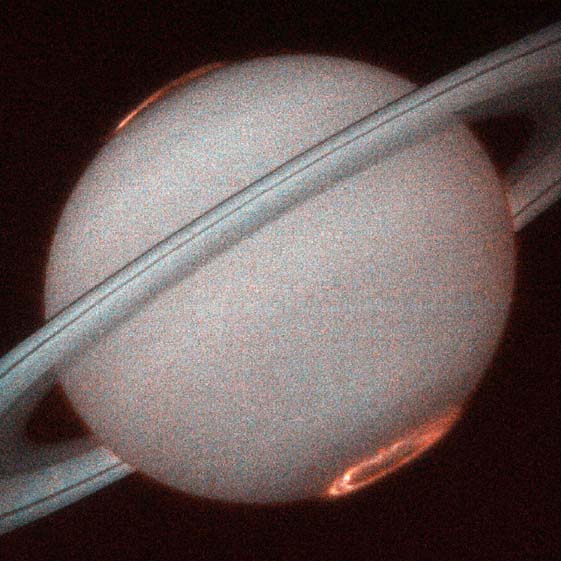 This is the Web Edition of "A Trip Into Space", a Coimbra-based electronic book on space science. Both the texts and the photos are by courtesy of National Aeronautics and Space Administration.
This is the Web Edition of "A Trip Into Space", a Coimbra-based electronic book on space science. Both the texts and the photos are by courtesy of National Aeronautics and Space Administration.
 This is the Web Edition of "A Trip Into Space", a Coimbra-based electronic book on space science. Both the texts and the photos are by courtesy of National Aeronautics and Space Administration. This is the Web Edition of "A Trip Into Space", a Coimbra-based electronic book on space science. Both the texts and the photos are by courtesy of National Aeronautics and Space Administration.
|
A Trip Into Space  Saturn Saturn  Saturn - Aurorae Saturn - Aurorae |
|
| See also: Saturn Fact Sheet |   |
This is the first image of Saturn's ultraviolet aurora taken by the Space Telescope Imaging Spectrograph (STIS) on board the Hubble Space Telescope in October 1997, when Saturn was a distance of 810 million miles (1.3 billion kilometers) from Earth. The new instrument, used as a camera, provides more than ten times the sensitivity of previous Hubble instruments in the ultraviolet. STIS images reveal exquisite detail never before seen in the spectacular auroral curtains of light that encircle Saturn's north and south poles and rise more than a thousand miles above the cloud tops.
Study of the aurora on Saturn had its beginnings just seventeen years ago. The Pioneer 11 spacecraft observed a far-ultraviolet brightening on Saturn's poles in 1979. The Saturn flybys of the Voyager 1 and 2 spacecraft in the early 1980s provided a basic description of the aurora and mapped for the first time planet's enormous magnetic field that guides energetic electrons into the atmosphere near the north and south poles. The first images of Saturn's aurora were provided in 1994-5 by the Hubble Space Telescope's Wide Field and Planetary Camera (WFPC2). Much greater ultraviolet sensitivity of the new STIS instrument allows the workings of Saturn's magnetosphere and upper atmosphere to be studied in much greater detail. These Hubble aurora investigations provide a framework that will ultimately complement the in situ measurements of Saturn's magnetic field and charged particles by NASA/ESA's Cassini spacecraft, now en route to its rendezvous with Saturn early in the next decade.
Two STIS imaging modes have been used to discriminate between ultraviolet emissions predominantly from hydrogen atoms (shown in red) and emissions due to molecular hydrogen (shown in blue). Hence the bright red aurora features are dominated by atomic hydrogen, while the white traces within them map the more tightly confined regions of molecular hydrogen emissions. The southern aurora is seen at lower right, the northern at upper left.
Credits: J.T. Trauger (Jet Propulsion Laboratory) and NASA.

Last Update: 2005-Nov-29